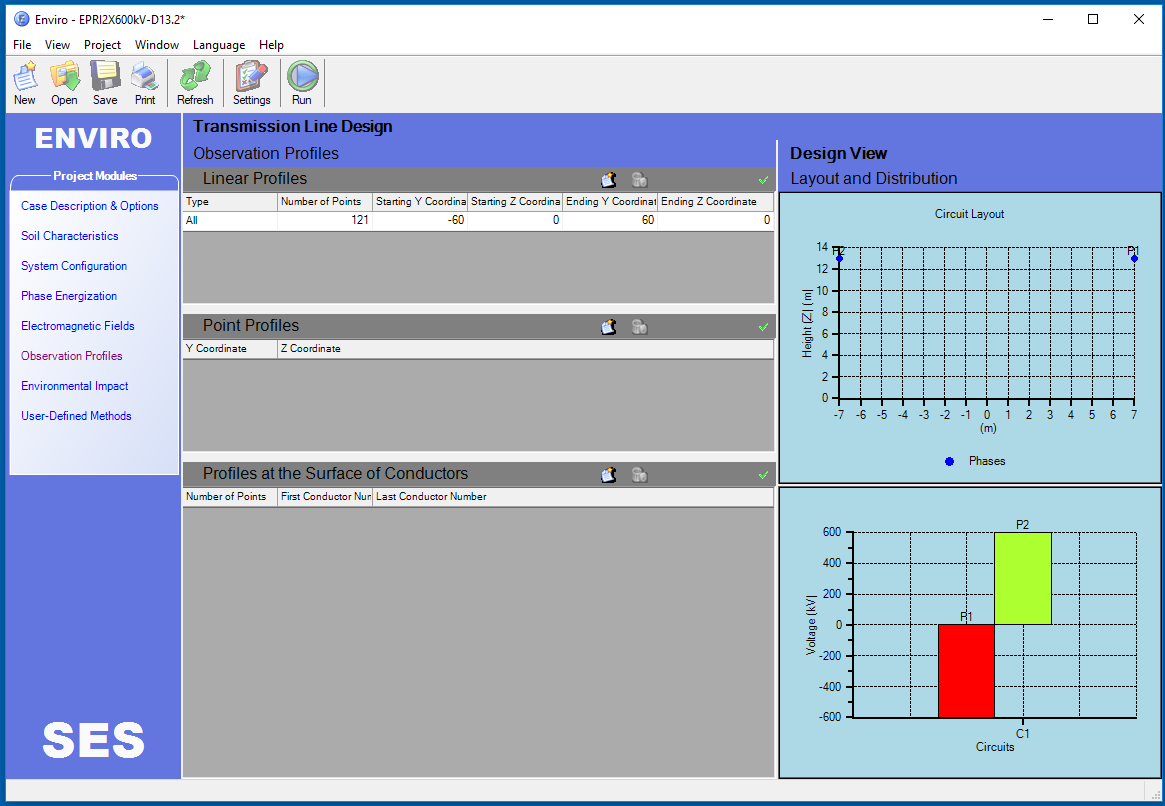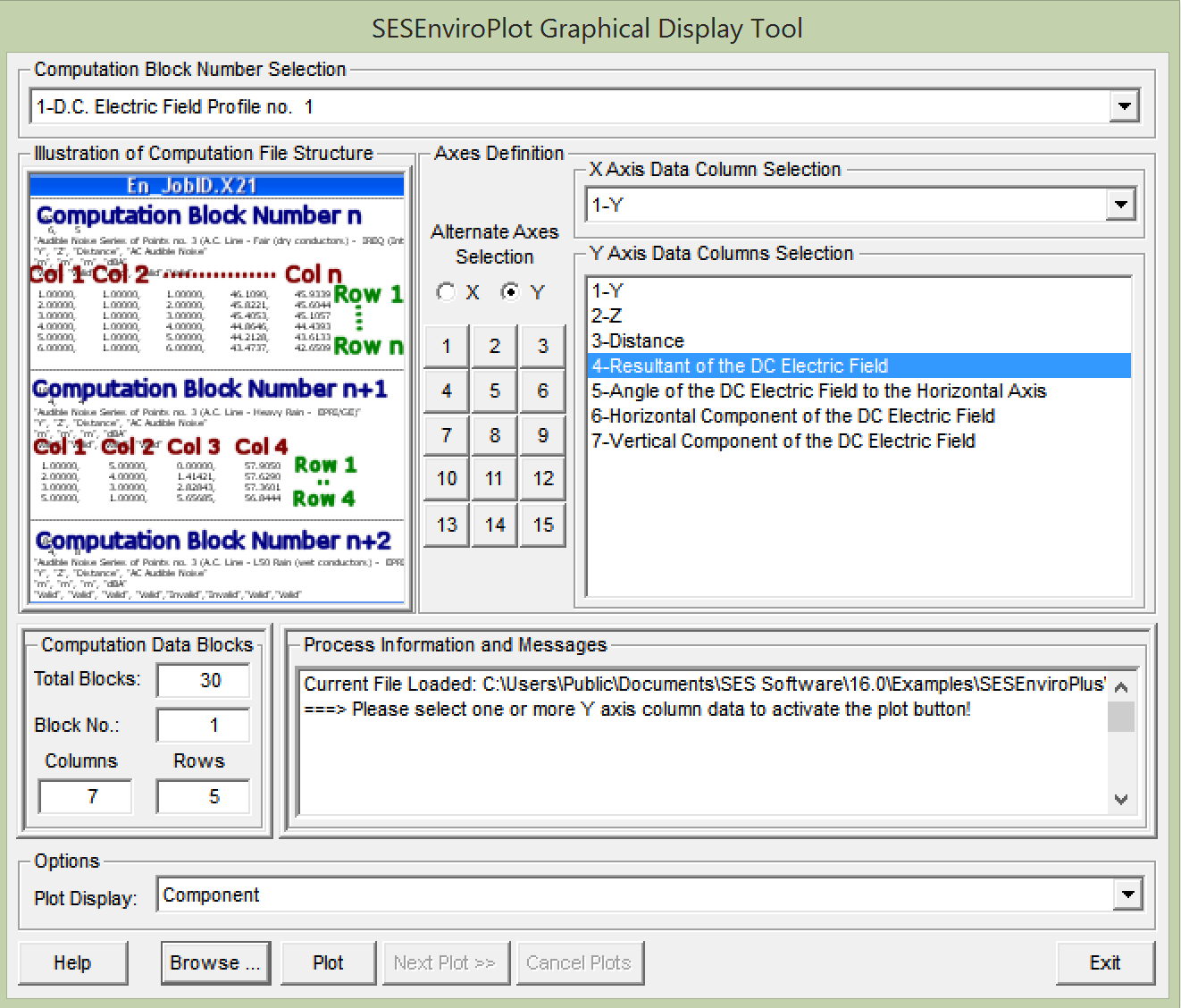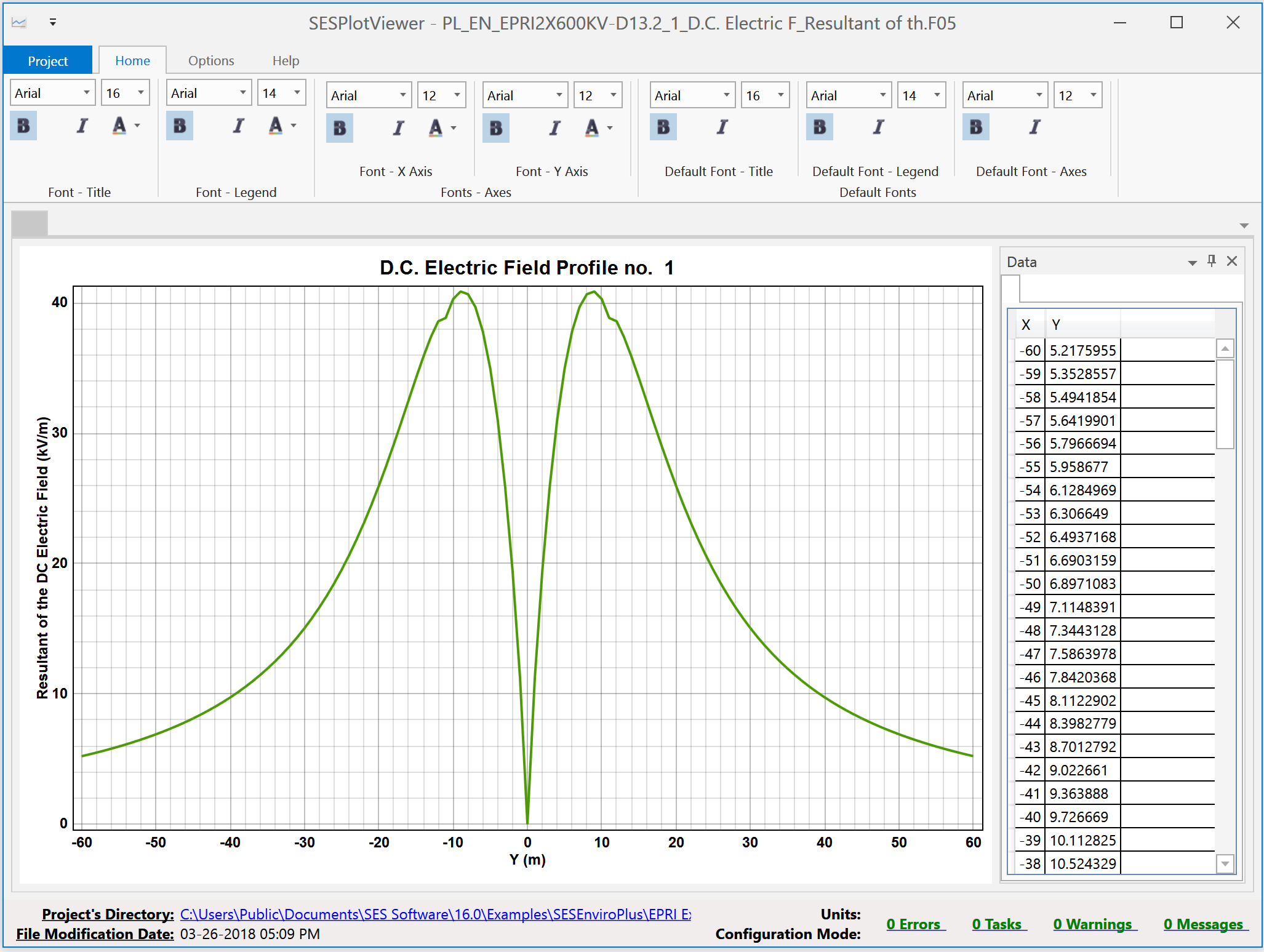The SESEnviroPlus software package is an electromagnetic environmental impact assessment analysis (EEIA) tool and the ideal software tool for the electric design of overhead AC and DC transmission lines. It quickly estimates line parameters, electric fields (with and without space charge effects), corona ion current density, magnetic fields, scalar potentials and corona parameters (loss, radio interference, audible noise) associated with arbitrary configurations of parallel electric lines, with any number and type of aerial conductors.
Computation Modules
TRALIN
Included Software Packages
This is a standalone package.
Technical Description
For transmission lines with operating voltages in excess of 345 kV, the key cost-determining factors of the design are legally imposed measures taken to limit radio interference, audible noise and corona electric field (for DC lines), generated by corona resulting from high electric field levels at the conductor surface. Reduction of the interference, noise and corona electric field can be accomplished by increasing the conductor size or the number of conductors per bundle or by moving the conductors further away from one another or increasing the height of the transmission lines, keeping in mind that the overall geometry is important. All of these measures have a considerable impact on cost. For example, simply raising 735 kV tower cross-arms by 1 m has been known to increase the cost of a line by as much as 10%! Power loss due to corona, during operation, represents another concern. Despite the obvious economic importance of optimizing a design with respect to corona effects, until now, no commercially available software has adequately addressed this design problem. SESEnviroPlus has eliminated this heavy burden.
The SESEnviroPlus software package is an analysis tool for the design of overhead AC and DC transmission lines. It quickly estimates line parameters, electric fields (with and without space charge effect), corona ion current density, magnetic fields, scalar potentials and corona parameters (loss, radio interference, audible noise) associated with arbitrary configurations of parallel electric lines, with any number and type of aerial conductors. The field and corona parameters can be evaluated at any location in the space around the lines or at the earth surface. The corona parameters calculated for high voltage lines are the surface gradient, the corona loss (CL), the radio interference (RI), the audible noise (AN), the DC corona electric field and ion current density. To aid the designer, the corona impact of individual phases, circuits or lines on corona-related parameters can be evaluated. The program is able to handle AC and DC lines (homo-polar, bipolar or hybrid) as well as hybrid lines for the calculation of the static electric field and corona electric field (for DC lines), the ion current density, the scalar potential, the magnetic field and the electric gradient.
Technical Features
-
Using SESEnviroPlus, you can compute the following line parameters: Maxwell potential coefficients, shunt capacitances, self and mutual impedances, and admittances for all conductors on a per-conductor basis, a per-phase basis, and a circuit basis, and with shield wires being either eliminated or treated as distinct conductors. It also provides the calculated symmetrical components.
-
Corona-related parameters are based on the best evaluation methods currently available: i.e., EDF, IREQ, EPRI, BPA, CRIEPI, ENEL, FGH, and GE, etc. The users can also specify their own methods to do the calculations.
-
SESEnviroPlus takes into account power frequency, skin effects, proximity effect, conductor surface conditions and earth characteristics in the evaluation of the corona and line parameters.
-
For HVDC lines, the corona electric field and ion current density are calculated accounting for different corona onset gradients for each bundle, different positive and negative ion mobilities and ion recombination in bipolar zones. The conductors in each bundle are treated individually and the system can be in homo-polar, bipolar or hybrid mode, and can include sky wires or non-corona conductors. The corona electric fields and ion current density can be calculated in the space or on the surface of the earth.
-
For overhead conductor arrangements with little regularity, conductors are specified one at a time and may be completely different from one another.
-
For regular overhead conductor arrangements, the conductor characteristics are specified on a per-circuit basis and the phase bundle configuration is specified to reduce data entry time.
-
The per-circuit basis and phase bundle input configuration allow asymmetrical bundles to be entered.
-
An extensive conductor database is available to facilitate input operations.
Analytical Methods Used in SESEnviroPlus
SESEnviroPlus is based on the following analytical methods:
-
Line Parameters:
All line parameters are computed using an enhanced algorithm based on the work of Gary, Deri and Abuelma'atti, which is the method used by FCDIST. The bundle reduction, ground-wire elimination and sequence components algorithms are all derived from the TRALIN module.
-
Option to Examine the Individual Contributions of Bundles and Circuits to the Corona Performance of a System:
The effect of each phase bundle or circuit upon the corona performance of the system can be evaluated independently by forcing the contribution of the corona on any number of circuits or phase bundles to zero while keeping those of interest. Note that it would not suffice to simply de-energize or physically remove phase bundles or circuits from the system under study to perform such an analysis, as the high frequency behavior of one circuit is affected by the presence of another parallel circuit, energized or not. SESEnviroPlus thus allows the user to evaluate, conveniently and accurately, the impact on an existing circuit of the addition of a new circuit, in terms of the surface gradient, the high frequency propagation characteristics, the radio interference and the audible noise.
-
Magnetic Field and Magnetic Flux Density:
The currents in the ground return conductors (i.e., neutral, shield, or static wires) contribute significantly to the magnetic fields in a balanced three-phase transmission system. SESEnviroPlus can optionally account for the presence of current in ground return conductors when computing the magnetic field and magnetic flux density. The determination of the currents in the ground return conductors is based on the assumption that the impedances of the terminations are always small compared with the total self-impedance of the ground return conductors (this is true when these conductors are sufficiently long). With this assumption, the value of the termination can be set to zero.
-
Electric Field and Space Potential:
The electric field and space potential are computed using a modified successive images method. This method yields a very accurate evaluation of the (modified) Maxwell coefficient matrix, the charges on the conductors, and the surface gradient. The program can compute the static electric field (non-ionized field) and space potential (scalar potential) anywhere in the vicinity of the line(s) or on/near the surface of the earth including cases where AC and DC lines can coexist.
-
Corona Electric Field and Ion Current Density:
An iterative method is used to solve Poisson’s equation for HVDC transmission line systems, accounting for the presence of space charges. The system can be in homo-polar, bipolar or hybrid mode, and can include sky wires or non-corona conductors. The conductors in the bundles are treated individually and can have different corona onset gradients for positive and/or negative energized conductors. Different positive and negative ion mobilities and ion recombination in bipolar zones are all accounted for.
-
Corona Parameters:
There are three main corona parameters evaluated by the SESEnviroPlus program: corona loss, radio interference, and audible noise. For each of these parameters, several alternative evaluation methods are available, based on the current state of the art. Each of these published methods is valid for a certain range of conductor radii, the configuration of the system and surface gradient, determined by the field testing conducted in the elaboration of these methods.
The generating functions which convert conductor surface electric fields into radio interference, audible noise and corona losses are separated in two types of methods: semi-empirical and empirical methods. In general, the semi-empirical methods are less specific to a particular type of transmission line and cover a wider range of designs. The evaluation methods used are based on the work of several individuals and research centers, the latter including: EdF, EPRI, IREQ, GE, BPA, CRIEPI, ENEL, FGH, CIGRE, Westinghouse, Corbellini & Pelacchi and the Anneberg Test Station.

A large variety of plots can be produced easily using the SESEnviroPlot tool. Its user interface and an example of one of the plot types that can be produced are shown below:






